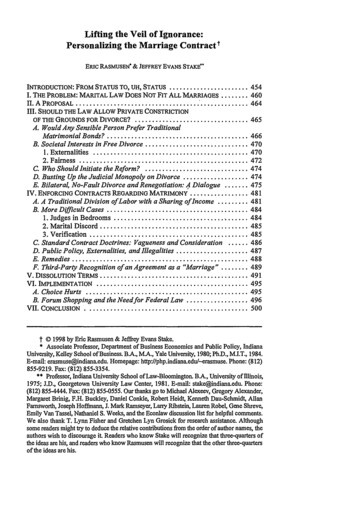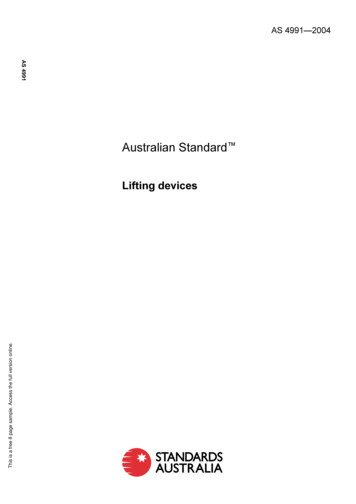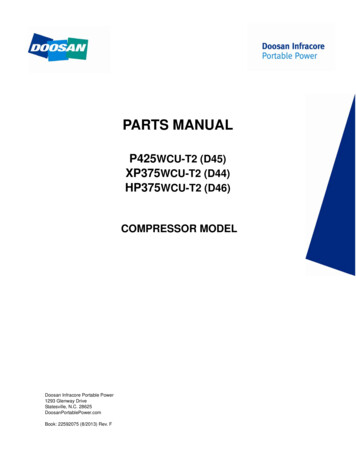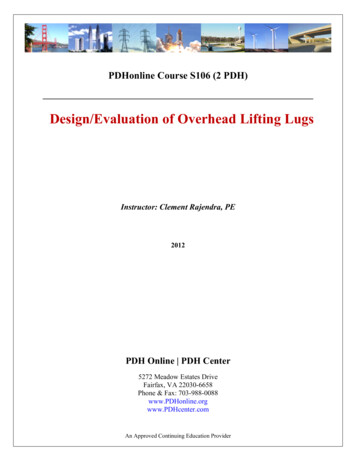
Transcription
Lifting the Veil of Ignorance:Personalizing the Marriage ContractERIcRASMUSEN" & JEFFREY EVANS STAKE"INTRODUCTION: FROM STATUS TO, UH, STATUS .I. THE PROBLEM: MARITAL LAW DOES NOT FIT ALL MARRIAGES .II. A PROPOSAL . .III. SHOULD THE LAW ALLOW PRIVATE CONSTRICTIONOF THE GROUNDS FOR DIVORCE? . . . . . . . . . . . . . . . . . . . . . . . . .A. Would Any Sensible PersonPrefer TraditionalMatrimonialBonds? .B. Societal Interests in FreeDivorce .1. Externalities .2. Fairness .454460464465466470470472C. Who Should Initiate the Reform? .474D. Busting Up the JudicialMonopoly on Divorce . 474E. Bilateral,No-FaultDivorce and Renegotiation: A Dialogue . 475IV. ENFORCING CONTRACTS REGARDING MATRIMONY . 481A. A TraditionalDivision ofLabor with a Sharing ofIncome . 481B. More Difficult Cases . 4841. Judges in Bedrooms . 4842. M arital Discord . 4853. Verification . 485C. StandardContractDoctrines: Vagueness and Consideration . 486D. Public Policy,Externalities, and Illegalities . 487E. Remedies . 488F. Third-PartyRecognition of an Agreement as a "Marriage". 489V. DISSOLUTION TERMS . 491VI. IMPLEMENTATION . 495A. Choice Hurts . 495B. Forum Shopping and the Needfor FederalLaw . 496VII. CONCLUSION . 500t 1998 by Eric Rasmusen & Jeffrey Evans Stake.* Associate Professor, Department of Business Economics and Public Policy, IndianaUniversity, Kelley School of Business. B.A., M.A., Yale University, 1980; Ph.D., M.I.T., 1984.E-mail: erasmuse@indiana.edu. Homepage: http://php.indiana.edu/--erasmuse. Phone: (812)855-9219. Fax: (812) 855-3354.** Professor, Indiana University School of Law-Bloomington. B.A., University of Illinois,1975; J.D., Georgetown University Law Center, 1981. E-mail: stake@indiana.edu. Phone:(812) 855-4444. Fax: (812) 855-0555. Our thanks go to Michael Alexeev, Gregory Alexander,Margaret Brinig, F.H. Buckley, Daniel Conkle, Robert Heidt, Kenneth Dau-Schmidt, AllanFarnsworth, Joseph Hoffinann, J. Mark Ramseyer, Larry Ribstein, Lauren Robel, Gene Shreve,Emily Van Tassel, Nathaniel S. Weeks, and the Econlaw discussion list for helpful comments.We also thank T. Lynn Fisher and Gretchen Lyn Grosick for research assistance. Althoughsome readers might try to deduce the relative contributions from the order of author names, theauthors wish to discourage it. Readers who know Stake will recognize that three-quarters ofthe ideas are his, and readers who know Rasmusen will recognize that the other three-quartersof the ideas are his.
INDIANA LAW JOURNAL[Vol. 73:453INTRODUCTION: FROM STATUS TO, UH, STATUSSir Henry Maine long ago identified a historical shift in the law from status tocontract.' In recent times we have seen the number of written agreements,warnings, and warranties increase vastly, a classic example being the movementin commercial leases from tenurial relationships to contractual agreements.2 Thischange has freed parties from many constraints imposed in the past on the basisof status. Yet marriage remains an exception. The large majority of marryingcouples have no written agreement beyond the marriage license, which bindsthem to state marriage laws.Even if a couple were to sign a contract setting out their terms of endearment,the courts might refuse to enforce it. This was consciously the attitude of courtsin the days before no-fault divorce. As the United States Supreme Court said in1888:[W]hilst marriage is often termed by text writers and in decisions of courtsa civil contract., it is something more than a mere contract. The consent ofthe parties is of course essential to its existence, but when the contract to1. See HENRY SUMNER MAINE, ANCIENT LAW 141 (Dorset Press 1986) (1861); cf 2 MAXWEBER, ECONOMY AND SOCIETY 671 (Guenther Roth & Claus Wittich eds., University of Cal.Press 1978) (1956) ("[T]he farther we go back in legal history, the less significant becomescontract as a device of economic acquisition in fields other than the law of the family andinheritance."). But see GRANT GILMORE, THE DEATH OF CONTRACT 3 (1974) ("Contract, likeGod, is dead."); Roscoe Pound, The End ofLaw as Developed in JuristicThought, 30 HARV.L. REv. 201, 219 (1917) ("[T]he whole course of English and American law today is belyingit unless, indeed, we are progressing backward.").2. Comparing the degrees of freedom in medieval tenancies and the oaths of loyalty oncebinding tenants to lords to the freedom allowed today (as evidenced by the sheer length ofleases), today's law would appear to be less a matter of status. The fact of tenancy told moreabout the relationship of yore. But see CARL E. SCHNEIDER & MARGARET F. BRINIG, ANINVITATION TO FAMILY LAW 348-49 (1995) (arguing current tenancies retain many elementsof status).3. Numerous authors have, however, advocated marital contracts. See, e.g., Richard W.Bartke, Marital Sharing-Why Not Do It by Contract?, 67 GEo. L.J. 1131, 1134 (1979)(proposing model statutory framework that would permit couples to elect a communityproperty arrangement for their marriage); Theodore F. Haas, The RationalityandEnforceabilityof ContractualRestrictions on Divorce, 66 N.C. L. REV. 879, 894 (1988) (proposing modelantenuptial agreements that impose financial burdens for initiating divorce); Joan M.Krauskopf & Rhonda C. Thomas, PartnershipMarriage:The Solution to an Ineffective andInequitableLaw ofSupport, 35 OHIO ST. L.J. 558 (1974) (discussing partnership agreementsbetween husbands and wives); Marjorie Maguire Schultz, ContractualOrderingof Marriage:A New Model for State Policy, 70 CAL. L. REv. 207 (1982) (arguing the utility of marriagecontracts to govern human interactions); Elizabeth S. Scott, RationalDecisionmakingAboutMarriage and Divorce, 76 VA. L. REV. 9, 4244, 79-81 (1990) (discussing the use ofprecommitment strategies, including antenuptial contracts, to lower divorce rates); Amy L.Wax, Bargainingin the Shadow of the Market: Is There a Futurefor EgalitarianMarriage?,84 VA. L. REV. (forthcoming May 1998) (Aug. 1997 manuscript at 91-92, on file with authors)("the ability to negotiate a binding antenuptial agreement would still have salutary effects,because it would arrest the bargaining squeeze and eliminate the potential for opportunism thatit presents").
1998]PERSONALIZING THE MARRIAGE CONTRACTmarry is executed by the marriage, a relation between the parties is createdwhich they cannot change.4The marriage contract remains as it has been for centuries, a contract ofadhesion. Marriage remains largely a matter of status,5 although that status istoday more ambiguous than in the past.This would not be surprising if the details of marriage law were unimportantbecause disputes rarely arose in marriages and formal law was rarely invoked.But we know this is not so. Disputes are inevitable and divorce is common, withthe results being hammered out in courts.6 Moreover, marriage law has becomemore important as control by social and religious norms has diminished.7 Whennonlegal rules were highly confining, legal rules had little room for influence.Since social liberation, the law's pull on behavior has been felt more strongly.The surprise is that marital law has not been similarly liberated. It still does notallow the parties the legal freedom to arrange their marriages as they wish withinthe much broader social boundaries.Not only has the law become more important, but the direction of its influencehas shifted importantly over the past forty years. Marriage law divides into threeparts: the terms during marriage, the grounds for dissolution, and the terms ofdissolution. The terms during marriage are few. The prohibition of adultery isnotable, but the law leaves most issues of relationship, such as how financialresources are allocated8 and where the children shall go to school,9 for4. Maynard v. Hill, 125 U.S. 190, 210-11 (1888). It is rare for the Court to engage insarcasm, but the facts of this case make one wonder. The holding in this case appears to be thatthe law of marriage is up to the legislature, not the parties to the marriage. But the facts are thata man went to Oregon, broke his promise to his Ohio wife to return, and successfully lobbiedthe legislature for a customized, unilateral, no-fault divorce without notifying his wife.5. But cf Jana B. Singer, The Privatizationof Family Law, 1992 Wis. L. REV. 1443(describing insightfully the trend toward privatization).6. Domestic-relations cases made up a third of civil filings in state courts of generaljurisdiction in 1992. See BRIAN J.OSTRUM ET AL., STATE COURT CASELOAD STATISTICSANNUAL REPORT 1992, at 23 (1994).7. See Michael J.Trebilcock & Rosemin Keshvani, The Role of Private Ordering inFamily Law: A Law and Economics Perspective,41 U. TORONTO L.J. 533 (1991).8. See Lacks v. Lacks, 189 N.E.2d 487, 488 (N.Y. 1963) (holding that a contract to paya spouse during marriage is void); see also McGuire v. McGuire, 59 N.W.2d 336, 342 (Neb.1953) (requiring a separation before a party can bring an action for maintenance). Therequirement of minimal support is discussed infra text accompanying notes 136-38. See alsonotes 153, 193.9. Even where the well-being of children is involved, courts resist intervening in disputesduring marriage.It would be anomalous to hold that a court of equity may sit in constantsupervision over a household and see that either parent's will and deterninationin the upbringing of a child is obeyed, even though the parents' dispute mightinvolve what is best for the child. Every difference of opinion between parentsconcerning their child's upbringing necessarily involves the question of thechild's best interest.Kilgrow v. Kilgrow, 107 So. 2d 885, 889 (Ala. 1958) (denying injunction restraining wife fromtaking child to certain school in violation of premarital agreement).
INDIANA LA W JOURNAL[Vol. 73:453determination outside the courts. Anglo-Saxon courts have traditionallyabstained from intervening in conduct during marriage and this has not changedwith the no-fault revolution.The grounds for dissolution" specify conditions under which the marriage canbe dissolved-adultery and intemperance, for example. The most dramaticchange in marriage law has occurred here. In the past, if one spouse alone soughta divorce, the law required him or her to show faulty behavior by the otherspouse.'" Modem law dispenses with the fault prerequisite, eliminating the rightof the innocent spouse to veto the divorce. 3 Under modem "unilateral," 4 "nofault"'5 divorce, one spouse may obtain a divorce against the wishes of the other10. See Saul Levmore, Love It or Leave It: PropertyRules, LiabilityRules, and ExclusivityofRemedies in Partnershipand Marriage,LAW & CONTEMP. PROBS., Spring 1995, at 221,225-26 (comparing the lack of remedies in partnership law to the lack of remedies in domesticrelations law); Katherine Silbaugh, TurningLabor into Love: Housework and the Law, 91 Nw.U. L. REv. 1, 29 (1996) (discussing "the traditional argument that marital obligations cannotbe consideration for a contract").11. "Grounds for dissolution" and "grounds for divorce" are used in this Articleinterchangeably.12. Before 1967, several states did allow divorce without a showing of fault if the couplehad been living "separate and apart" for a period of time. Divorce on this ground withoutmutual consent was risky because separation without agreement could have been found to bedesertion. No state allowed one spouse to divorce the other against his or her wishes withoutproving fault on the part of the spouse wishing to continue the marriage.Separation for cause, without divorce, has been available for a long time. According toBlackstone:Divorce a mensa et thoro is when the marriage is just and lawful ab initio, andtherefore the law is tender of dissolving it; but, for some supervenient cause, itbecomes improper or impossible for the parties to live together: as in the case ofintolerable ill temper, or adultery, in either of the parties. For the canon law,which the common law follows in this case, deems so highly and with suchmysterious reverence of the nuptial tie, that it will not allow it to be unloosed forany cause whatsoever, that arises after the union is made.1 WILLIAM BLACKSTONE, COMMENTARIES ON THE LAW OF ENGLAND 428 (photo. reprint 1979)(1765).13. According to Elizabeth Schoenfeld, "[o]n September 5, 1969, with a stroke of his pen,California governor Ronald Reagan wiped out the moral basis for marriage in America."Elizabeth Schoenfeld, Drumbeatsfor Divorce Reform, POL'Y REv., May-June 1996, at 8, 8.Within five years, 44 other states had followed with laws allowing courts to grant divorcessought unilaterally on the ground of"irreconcilable differences" or "irretrievable breakdown."See id. For a brief history of the development of no-fault, see SCHNEIDER& BRINIG, supra note2, at 71-94.14. "Unilateral" divorce includes four kinds of situations: (1)divorce against the wishesof one spouse based on the fault of that spouse, (2) divorce against the wishes of one spousenot based on any fault by that spouse, (3) (rarely) divorce requested by one spouse where theother spouse is unavailable and his or her preference is unknown, and (4) divorce sought byone party where the other party does not contest the divorce. Cases in the last category aresimilar to bilateral (or mutual) divorces, in that they are not contested. A huge number of casesare uncontested.15. "No-fault" divorce refers in this Article to divorce that parties may obtain without ashowing of fault. The reader should keep in mind, however, that fault still plays a role in theconsequences of divorce in some states. A pure "no-fault divorce" state would neither require
1998]PERSONALIZING THE MARRIAGE CONTRACTwithout showing fault. 16 Just a few years ago it seemed that the change tounilateral, no-fault divorce was an irreversible landslide.' 7 But the earth mightnot have moved. Divorce law is swinging back in the other direction. 8 BetweenJanuary and April 1996, legislators in eighteen states introduced bills to makedivorce more difficult. 9 The no-fault revolution is under counterattack.The terms of dissolution20 specify what happens after dissolution, including thecustody of children and division of property and future income. Important andcomplicated changes have also occurred in this area. Maintenance has diminishedand fault has less impact on the terms of divorce, in keeping with the revolutionin divorce grounds. Women have been granted fewer privileges special to theirsex such as child custody or alimony.These were no small reforms. Few legal changes in twentieth-century Americahave generated such large wealth transfers between private individuals. Whichspouse benefited from the change depended on the particular marriage. The newlaw gave new freedom to spouses wanting out of marriage. The law also madeit possible for the poorer spouse to gain control of some existing financial assetsby divorcing the richer spouse against his or her wishes. And the new lawnor allow the parties to show fault in any part of a divorce proceeding.16. See MARY ANN GLENDON, ABORTION AND DIVORCE IN WESTERNLAW108 (1987);HARRY D. KRAUSE, FAMILY LAW IN A NUTSHELL 339 (2d ed. 1986); Leora Friedberg, DidUnilateralDivorce Raise Divorce Rates? Evidence from Panel Data, 88 AM. ECON. REV.(forthcoming 1998) (Jan. 1997 manuscript at tbl.1, on file with authors) (listing five stateswhich do not allow unilateral, no-fault divorce: Arkansas, Delaware, Mississippi, New York,and Tennessee); Marsha Garrison, How Do Judges Decide Divorce Cases? An EmpiricalAnalysis ofDiscretionaryDecisionmaking,74N.C. L. REV. 401, 420 n.64 (1996) ("Only threestates. restrict no-fault divorce to cases involving spousal agreement.") (citing MISS. CODEANN. § 93-5-2(1) (1994); N.Y. DOM. REL. LAW § 170(6) (McKinney 1988); TENN. CODE ANN.§ 36-4-101(12) (1991) (requiring separation agreement for couples with minor children));Scott, supra note 3, at 17 n.23 (stating that only two states require consent of both spouses toa no-fault divorce). Unfortunately, tables categorizing divorce grounds sometimes fail toidentify states such as Virginia that do not allow unilateral, no-fault divorce. See Linda D.Elrod & Robert G. Spector, A Review of the Year in Family Law: Of Welfare Reform, ChildSupport, and Relocation, 30 FAM. L.Q. 765, 807 tbl.4 (1997). It is stunning that the FamilyLaw Quarterlysummary table ignores the important difference between unilateral and mutualno-fault divorce.17. In writing MandatoryPlanningfor Divorce, Stake presumed that the reform allowingunilateral divorce would not soon be reversed. See Jeffrey Evans Stake, MandatoryPlanningfor Divorce, 45 VAND. L. REV. 397, 409-10 (1992). In writing their casebook, Schneider andBrinig said "Is no-fault divorce desirable? No one advocates returning to the old regime .SCHNEIDER & BRINIG, supra note 2, at 94.18. Some of the recent reforms in Britain have followed this pattern. In 1996, the first majorchange in marriage law since 1969 in England and Wales required mandatory "cooling off"periods, delaying most divorces twelve to eighteen months instead of the earlier seven-monthaverage. But in other ways, Britain is out of phase. As in earlier American reforms, the role offault has been sharply diminished. See Robin Knight, In GreatBritain, an Easier Out, U.S.NEWS & WORLD REP., Sept. 30, 1996, at 60.19. See Hanna Rosin, Separation Anxiety: The Movement to Save Marriage, NEWREPUBLIC,May 6, 1996, at 14, 14. In one state, Louisiana, the bill has been signed into law.See infra note 169.20. "Terms of dissolution" and "terms of divorce" are used in this Article interchangeably.
INDIANA LA W JOURNAL[Vol. 73:453reduced the obligations of the spouse with greater earning potential afterdivorce.2' Assuming that women and men had equal desire to be free of theirspouses," and assuming that in dividing assets "equitably" courts paidsubstantial attention to the actual contribution (monetary and otherwise) of bothspouses in amassing the assets,' the revolution in the grounds for divorce would,at first cut, have had equal impact on men and women as groups. However,assuming that men had more market-income potential, 4 the revolution in theterms of divorce advanced the interests of men.25 Even more stunning than thepotentially huge net gains in wealth for one sex at the expense of the other wasthe breadth of the impact. In every marriage, a change in the balance of powerand wealth occurred one way or the other, probably from the more devoted anddependent to the less devoted and dependent.2621. See Smith v. Smith, 547 N.E.2d 297, 300 (Ind. Ct. App. 1989) (stating in dictum thatthe "trial court may order spousal maintenance only after a showing of incapacitation").However, divorcing spouses "crafting their own agreements may provide for maintenancewithout such a showing." Id."[W]hile a divorce court is prohibited from fashioning an award of spousalmaintenance containing a provision that the award is not subject to modification,divorcing couples are perfectly free to craft their own agreements-as did theparties in the present case-for an award of maintenance that is not subject tomodification."Roberts v. Roberts, 644 N.E.2d 173, 175 (Ind. Ct. App. 1994) (alteration added) (quotingBowman v. Bowman, 567 N.E.2d 828, 830 (Ind. Ct. App. 1991)). Thus, divorcing spouseshave more flexibility in crafting their property settlement by mutual agreement than do divorcecourts by commands.22. This assumption is suspect If men's filings for divorce increased more than women's,that would suggest that more men desired to leave a non-faulty wife than vice versa, and thatthe new law benefited more men than women.23. This assumption is also suspect in that courts (dividing assets "equitably") often lookprimarily to the financial contributions of each spouse, undervaluing nonmonetarycontributions by women.24. See PAULA ENGLAND & GEORGE FARKAS, HOUSEHOLD EMPLOYMENT AND GENDER 16364 (1986) (describing the sex gap in wages); VICTOR R. FUCHS, WOMEN'S QUEST FORECONOMIC EQUALITY 44-45 (1988) (stating that women work fewer paid hours than do men);MILTON REGAN, FAMILY LAW AND THE PURSUIT OF INTIMACY 155 (1993) (stating that "womenare more likely than men to make career sacrifices in order to meet family responsibilities, andtherefore often are economically dependent on men") (citing FUCHS, supra,at 140).25. This proposition might be tested empirically if it could be determined whether menbecame more willing to marry after divorce reform. If they did become more willing to marry,that would support the claim that reform reduced the ex ante costs of marriage for them.Overall marriage rates have diminished, however. See Marga'ret F. Brinig & Steven M. Crafton,Marriageand Opportunism, 23 J. LEGAL STUD. 869, 884-85 (1994) (discussing the evidenceof fewer women getting married-91 per 1000 in 1988 compared with 147.2 per 1000 in1967-and the woman's lack of bargaining power in marriage).26. This legislative wealth trahsfer was challenged in litigation, without success. See In reMarriage of Franks, 542 P.2d 845, 850 (Colo. 1975) (en banc) (rejecting argument that theno-fault divorce grounds in the Uniform Dissolution of Marriage Act violated the contractclause of the state constitution); see also In re Marriage of Walton, 104 Cal. Rptr. 472, 475-76(Ct. App. 1972) (holding that a no-fault divorce was not an impairment of wife's contract).Given the current scope of the Takings Clause, perhaps that should have instead been the basisof the challenge. See Dolan v. Tigard, 512 U.S. 374, 391 (1994) (stating that the burden is on
1998]PERSONALIZING THE MARRIAGE CONTRACTThe destruction of existing marital rights by the shift to new default rulesoccurred at the same time the Supreme Court was establishing that there existsa right to marriage: "The freedom to marry has long been recognized as one ofthe vital personal rights essential to the orderly pursuit of happiness by freemen." Although this seems odd, it perhaps became easier for the Court toestablish such a right when marriage did not, legally, mean much. The fewerrights that obtain upon marriage, the less interest the state has in overseeing it.Interestingly enough, the Court also found a "right to divorce" of sorts, holdingthat the state cannot require indigents to pay court fees in order to obtain adivorce.2"In addition to changes wrought in the relative power and wealth of maritalparties, the legal reforms radically changed the incentives married personsconfronted. With no assurance that a marriage would continue and no securityfor either party in the judicially determined terms of divorce, the parties to amarriage remained nearly as financially insecure after marriage as they had beenwhen single.29 Spreading of financial losses within the marital unit could nolonger be relied upon when one spouse had the option to bail out of a householdin difficulty. Devoting time and energy to producing assets useful to the marriagebecame riskier A career became a safer bet for either party. People across thecountry responded to those new incentives, spending more time at the office andless at home. 1the government to make findings of fact showing rough proportionality in exaction cases); FirstEnglish Evangelical Lutheran Church v. County of Los Angeles, 482 U.S. 304, 318 (1987)(holding that a deprivation of land-use rights is no less a taking simply because it is temporary);Hodel v. Irving, 481 U.S. 704, 717-18 (1987) (determining that it is a taking to stop a personfrom passing assets by will and by intestate succession even if person still has a right to transferassets at death by settling a trust); Loretto v. Teleprompter Manhattan CATV Corp., 458 U.S.419, 43 6-37 (1982) (stating that no physical invasion is too small to be a taking).27. Loving v. Virginia, 388 U.S. 1, 17 (1967); see also Zablocki v. Redhail, 434 U.S. 374(1978) (holding that the state cannot prevent marriage by someone unable to meet hisobligation to support his existing children).28. See Boddie v. Connecticut, 401 U.S. 371 (1971).29. The new legal regime also created an incentive to look more carefully for a spouse thatwould stay married, if that spouse's income was important30. See generally Brinig & Craflon, supra note 25, at 883, 887; Lloyd Cohen, Marriage,Divorce,and QuasiRents; or "IGave Him the Best Years of My Life ", 16 J. LEGAL STUD. 267,288-89 (1989).31. The participation rate for females aged 25-44 was 47.5% in 1970, see U.S. BUREAU OFCENSUS, U.S. DEP'T OF COMMERCE, HISTORICAL STATISTICS OF THE UNITED STATES, COLONIALTIMES TO 1970, at 132 (1970), while that for females aged 25-34 was 74.9% in 1995, see U.S.DEP'T OF COMMERCE, STATISTICAL ABSTRACT OF THE UNITED STATES,1996, at 393 tbl.615(1996). For an economic analysis of women's work levels, see Allen Parkman, Why AreMarriedWomen Working So Hard?, 18 INT'L REV. L. &ECON. (forthcoming 1998) (attributingsome work to fear of divorce), and ALLEN M. PARKMAN, NO-FAULT DIVORCE: WHAT WENTWRONG? (1992).
INDIANA LA W JOURNAL[Vol. 73:453I. THE PROBLEM: MARITAL LAW DOES NOT FIT ALLMARRIAGESCan it be that society had changed so radically and completely that the oldrules were inappropriate for every couple? It seems doubtful that the changeaway from fault as a component of marriage law followed a wholesale shift in thepublic conception of marriage. Even if many or most couples preferred the newsystem, not every couple wanted the law to create incentives for them to devoteless time to home and family. Indeed, it would be unusual in a democracy for themajority to wait until the minority agreed with it before enacting its view of thebest law. As is usually the case, the legal change in marriage law followed apartial shift in values, with the result that the new rules (like the old) fit only aportion (even if a majority) of the population.32 Predictably, the new rules fitsome couples well but others poorly.33Why did this group of marital conservatives (if we may so term those personsfor whom the old rules better fit their marital aspirations) not try to escape theconsequences of the new default rules by individualized contracting? When thelaw first changed, many couples were unaware of how the changes would shiftthe allocation of power and wealth in their relationships. But even if theyrecognized the distributional consequences, they could not respond. The lawyerlyresponse would be to draw up a new agreement for existing marriages,conforming more to the old legal default. But it was too late. Once the law hadchanged, its shadow had moved, and the bargains made in the shadow of the lawwould never be the same. Precisely because the legal change had taken awayrights from the losing spouse, that spouse had no assets with which to buy themback.Whatever the effects on married persons, the revolution in the law did notmuch change the existing power and assets of single parties. Unlike alreadymarried persons, singles could have tried to write contracts binding themselvestogether financially, either approximating the traditional marriage or inventinga new version of commitment to interdependence.34 That this did not happenimmediately presents no puzzle. Even when there are no signaling problems," it32. Among the direct beneficiaries of the change in law were legislators who voted for it.The chairman of the California Senate Judiciary Committee, James Hayes, was divorced forfault in 1966 by his wife of 25 years and ordered to pay alimony and child support. He oversawthe drafting of the statute and its accompanying report in 1969, and used it himself in 1972 toend his child support and cut his alimony. In 1973, he managed to get alimony further reduced,and the judge told Mrs. Hayes to go out and get ajob. If she had been the politician, perhapshistory would be different. See William A. Gaston, Divorce American Style, PUB. INTEREST,Summer 1996, at 12, 12-13.33. The decrease in marriage rates after unilateral, no-fault divorce was adopted suggeststhat the new rules make marriage less attractive. See generally Elisabeth M. Landes, TheEconomics ofAlimony, 7 J. LEGAL STUD. 35 (1978) (discussing optimal specialization).34. Of course, many cohabiting couples now have contracts, especially since Marvin v.Marvin, 557 P.2d 106, 122 (Cal. 1976) (upholding oral contract between unmarried cohabitingpersons with respect to property division).35. See discussion infra note 41.
1998]PERSONALIZING THE MARRIAGE CONTRACTtakes time for individuals to understand and conform to new legal regimes. Butwe have now had some thirty years of liberalized divorce rules, and althoughthere are many calls for a public return to fault regimes for divorce, privatemarriage contracts tailored to individual needs and desires remain uncommonamong first-time newlyweds. 6.There are a number of reasons we have seen little contracting. The courts oftendo uphold contracts relating to the division of assets on divorce,17 asdistinguished from the grounds for divorce, 8 but legal drafting is costly. Also,contracting on the terms of divorce has little attraction because most people thinktheir marriages will not fail. 9 Perhaps more important, most people were and areunaware of the important behavioral incentives the ter
a divorce, the law required him or her to show faulty behavior by the other spouse.'" Modem law dispenses with the fault prerequisite, eliminating the right of the innocent spouse to veto the divorce. 3 Under modem "unilateral," 4 "no-fault"'5 divorce, one spouse may obtain a










